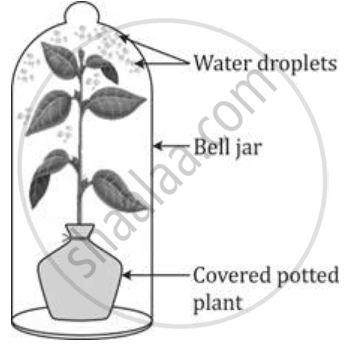Advertisements
Advertisements
प्रश्न
Discuss the factors responsible for ascent of xylem sap in plants
उत्तर १
Xylem sap ascends mainly due to forces generating in the foliage of plants as a result of active transpiration. Thus, the factors which enhance the rate of transpiration are also the factors responsible for ascent of xylem sap in plants.
Various factors responsible for ascent of xylem sap in plants are as follows:
(i) Capillarity: There is limited rise of water in narrow tubes or capillaries due to forces of cohesion amongst molecules of water and their property of adhesion to other substance.
(ii)Root pressure: It is positive pressure that pushes sap from below due to active absorption by root
(iii)Transpiration pull: Transpiration in aerial parts brings the xylem sap under negative pressure or tension due to continuous withdrawal of water by them. Water column does not break due to its high tensile strength related to high force of cohesion and adhesion.
उत्तर २
Transpirational pull is responsible for the ascent of water in the xylem. This ascent of water is dependent on the following physical factors:
Cohesion – Mutual attraction between water molecules
Surface tension – Responsible for the greater attraction between water molecules in liquid phase than in gaseous phase
Adhesion – Attraction of water molecules to polar surfaces
Capillarity –Ability of water to rise in thin tubes
These physical properties of water allow it to move against gravity in the xylem.
APPEARS IN
संबंधित प्रश्न
An apparatus, as shown below, was set up to investigate a physiological process in plants. The setup was kept in sunlight for two hours. Droplets of water were then seen inside the bell jar. Answer the questions that follow:

- Name the process being studied.
- Explain the process named above in Q.3(a)(i).
- Why was the pot covered with a plastic sheet?
- Suggest a suitable control for this experiment.
- Mention two ways in which this process is beneficial to plants.
- List three adaptations in plants to reduce the above mentioned process.
Define the three processes by which plants absorb water and minerals from the soil.
Differentiate between osmosis and transpiration.
How does transpiration help in the uptake of water from the soil?
Give a reason.
What happens to the movement of the air-bubble if the apparatus shown above is kept in front of a fan?
Distinguish between the following :
Cuticular transpiration and lenticular transpiration
Choose the correct answer:
More water loss in plants is the cause of wilting. This can be checked by ____________
An apparatus as shown below was set up to investigate a physiological process in plants. The setup was kept in sunlight for two hours. Droplets of water were then seen inside the bell jar. Answer the questions that follow:

Mention two ways in which this process is beneficial to plants.
Define the following Term:
Transpiration
What causes the opening and closing of guard cells of stomata during transpiration?
Analogy:
Photosynthesis: ______:: Transpiration: Stomata
Which one is not related to transpiration?
Describe briefly the three physical properties of water which helps in ascent of water in xylem.
Observe the diagram and answer the following;
 (i) |
 (ii) |
- Are these types of guard cells found in monocots or dicots?
- Which of these shows a higher water content (i) or (ii)?
- Which element plays an important role in the opening and closing of stomata?
The radio labelled carbon in carbon dioxide supplied to potato plants in an experiment was seen in the tuber eventually. Trace the movement of the labelled carbon dioxide.
Briefly describe the following:
Angina Pectoris
Why is transpiration less in the still wind?
Transpiration occurs:
